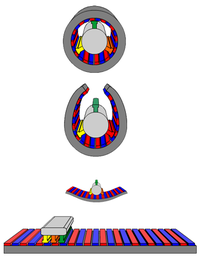
Photo from wikipedia
This article proposed a new design of a dc linear motor for the propulsion of high-temperature superconducting (HTS) magnet levitation (maglev) transports. This design is effective because it can reduce… Click to show full abstract
This article proposed a new design of a dc linear motor for the propulsion of high-temperature superconducting (HTS) magnet levitation (maglev) transports. This design is effective because it can reduce the HTS maglev system cost and compact the system components by improving the integration of the three main functions of levitation, guidance, and propulsion. The design was made for the desired onboard coil so that it is applicable to the existing magnet track of the HTS maglev system. Meanwhile, the previous independent linear motor can be replaced. The idea was first evaluated by the finite-element simulation and optimized to obtain an effective propulsion force. Based on the simulation results, a dc linear motor principle model was designed and fabricated. The propulsion force was obtained during experiments and verified the feasibility of the proposed idea. With further optimization, this method could be applied to the future HTS maglev system.
Journal Title: IEEE Transactions on Applied Superconductivity
Year Published: 2020
Link to full text (if available)
Share on Social Media: Sign Up to like & get
recommendations!